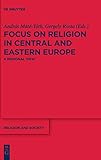Focus on Religion in Central and Eastern Europe : A Regional View / ed. by András Máté-Tóth, Gergely Rosta.
Material type: TextSeries: Religion and Society ; 68Publisher: Berlin ; Boston : De Gruyter, [2016]Copyright date: ©2017Description: 1 online resource (XI, 204 p.)Content type:
TextSeries: Religion and Society ; 68Publisher: Berlin ; Boston : De Gruyter, [2016]Copyright date: ©2017Description: 1 online resource (XI, 204 p.)Content type: - 9783110228113
- 9783110390681
- 9783110228120
- 200.947
- BL980.C39
- online - DeGruyter
- Issued also in print.
| Item type | Current library | Call number | URL | Status | Notes | Barcode | |
|---|---|---|---|---|---|---|---|
 eBook
eBook
|
Biblioteca "Angelicum" Pont. Univ. S.Tommaso d'Aquino Nuvola online | online - DeGruyter (Browse shelf(Opens below)) | Online access | Not for loan (Accesso limitato) | Accesso per gli utenti autorizzati / Access for authorized users | (dgr)9783110228120 |
Frontmatter -- Foreword -- Table of Contents -- The Region of Central and Eastern Europe: A Geography and Religious Studies Approach -- Religion and Values in Central and Eastern Europe -- Religion and Nation -- Eastern Orthodoxy and Its Churches in Central and Eastern Europe -- Church-Related Higher Education in Central and Eastern Europe Twenty Years after Political Transition -- Mapping New Religious Movements in Central and Eastern Europe: Approaching the Problem -- Sociology of Religion and Social Network Based Approaches in North America and Central and Eastern Europe: A Review -- Index of Persons
restricted access online access with authorization star
http://purl.org/coar/access_right/c_16ec
Different religious groups in Central and Eastern Europe influenced societies in the region after the fall of Communism and continue to play a crucial role in culture, politics, social networks and value transformations. As part of the REVACERN (Religion and Values in Central and Eastern Europe Research Network) project – supported by the EU Sixth Framework Program – more than 70 researchers from 15 countries in the region analyzed and discussed the most important trends in values, religions and religious communities and presented their findings in a comparative way. They tested well-known theories of secularization, nationalism, democracy and pluralism in the colorful region Central and Eastern Europe. This book summarizes their most important findings in seven chapters, addressing religion and its entanglements with geography, values, nationalism, Orthodoxy, education, legal regulation, civil society, social networks, new religious movements and new forms of religiosity. Each chapter also provides a regional overview.
Issued also in print.
Mode of access: Internet via World Wide Web.
In English.
Description based on online resource; title from PDF title page (publisher's Web site, viewed 28. Feb 2023)


